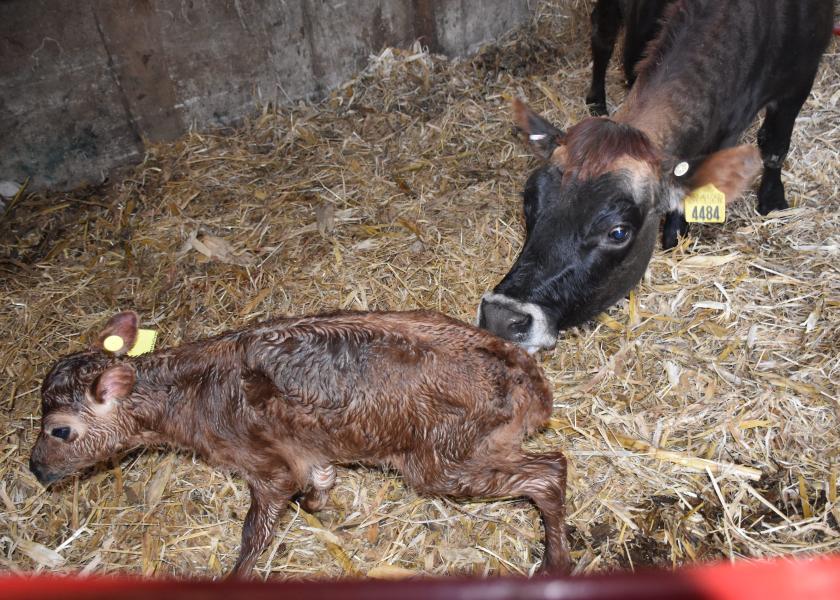A Disease You Don't Think About is Taking a Health Toll on Dairy Calves

If you listed the top three disease problems in young dairy calves, diarrhea and pneumonia would likely come to your mind immediately. The third one might not be as obvious: umbilical infection.
Nonetheless, bovine veterinarians Dave Renaud and Matthias Wieland, respectively, say their consensus is it ranks third, based on their research and experience on dairy farms in North America.
Renaud, a veterinarian and researcher with Ontario Veterinary College, University of Guelph, considers navel infections to be the most under-diagnosed disease issue in dairy calves in Canada, particularly in the first two weeks of life.
“Umbilical infections have serious repercussions – increased risk of mortality, reduced survival through first lactation and reduced rate of gain,” he says.
Besides the local infection and inflammation, the practitioners say bacteria can spread through the blood stream into joints, lungs, kidneys, and other organs, causing severe complications such as septicemia and arthritis.
Significant Mortality
Umbilical infections also are associated with increased dairy calf mortality. While information on mortality numbers in Canada and the U.S. is scarce, Renaud and Wieland cite a study from 1998 that indicates umbilical infections increase mortality two-fold*.
In addition, a 2018 study they cite confirmed that calves entering a veal facility with an umbilical infection were 2.4 times more likely to die (6% mortality with the infection compared to 2.7% without).
Even so, the percentage of calves diagnosed with umbilical infection varies widely – between 1% and 34% – according to Wieland, a professor in the Department of Population Medicine and Diagnostic Sciences at the Cornell University College of Veterinary Medicine.
In Canada, national producer treatment records show only 3% of dairy calves are treated for the problem, though Renaud believes the problem is much more widespread than that percentage indicates.
Few Visual Symptoms
For a health issue so significant, why does it often escape detection and treatment? While symptoms of diarrhea and pneumonia are often readily seen, that’s rarely the case with an umbilical infection.
Instead, Renaud says you must feel the umbilicus and palpate it to determine if it’s enlarged, indicating infection is present. Plus, he adds, “You have to feel a number to know what an enlarged one feels like.”
For training purposes, he has veterinary students use a 1.3 cm wooden dowel as a reference to gauge whether a calf umbilicus is normal or enlarged. This reference works best for calves that are at least a couple of weeks old.
Other considerations upon examination include whether there is heat and moisture present, any foul-smelling discharge and whether the calf, regardless of age, exhibits any reaction, either pain or sensitivity during examination.
If a calf is pulled aside for evaluation, even if it’s routine, Renaud encourages veterinarians and producers to check the umbilicus as part of their total calf care process.
For the Prevention of Disease:
Renaud and Wieland, respectively, offer some best management practices for bovine practitioners and producers to prevent umbilical infections and/or provide identification and treatment. They are:
Improve maternity pen hygiene, such as help with the design of maternity pens, develop a protocol for bedding frequency, monitor maternity hygiene, minimize manure contamination.
Address colostrum management on farms, including timely colostrum harvest (less than 8 hours), evaluation of colostrum quality, feeding of high-quality colostrum in a timely manner (less than 4 hours), advocating for a second colostrum feeding.
Develop a protocol to incorporate examination of umbilical structures at different times. Examinations could be incorporated in other management tasks such as moving from pre-conditioning into group housing, time of dehorning or vaccination, and time of weaning to facilitate early detection and treatment.
What About Navel Dips?
Wieland says he believes the use of a navel dip after a calf’s birth can aid in drying the umbilical cord and also kill bacteria that could be present.
“I support the use of dips, though few studies such as that from Grover and Godden have shown a positive effect,” says Wieland. “I speculate that shortcomings in maternity pen hygiene and calf housing systems overpower a possible positive effect of navel dips,” he adds.
As for the type of dip to use, he prefers iodine-based products.
“More important than the type of dip used is the need for stellar hygiene when using it. Additionally, an increased frequency of dipping (i.e., for several days) may help improve the efficacy, though future research is needed to prove this theorem,” he says.
Given current regulations, an alternative to iodine, which was long considered the gold standard, may be needed. Options would include 2% chlorhexidine, as well as proprietary products specifically developed as navel dips, according to Hayley Spring, MS, DVM, Penn State University.
Dipping, rather than spraying, assures thorough coverage and can allow dip to get inside navel openings that spray cannot reach. But unlike a sprayer, a dirty dip cup can spread infections, she adds.
Spring says an easy, inexpensive way to get around this is to use bathroom-sized disposable paper cups. Fill the cup with about 1 to 2 ounces of dip, get all the calf’s umbilical tissue into the cup, hold it against the calf’s belly, and give it a good shake. This will provide coverage all the way to the abdominal wall.
When the job’s done, the cup can be discarded.
Reference:
*Donovan, G. A., I. R. Dohoo, D. M. Montgomery, and F. L. Bennett. 1998b. Associations between passive immunity and morbidity and mortality in dairy heifers in Florida, USA. Prev. Vet. Med. 34:31–46.
When Sick Dairy Calves on the Farm are Unlikely to Recover
Weaning Considerations for Healthy Calves
The Pros and Cons of Caustic Paste
9 Practices to Help Resuscitate a Newborn Calf
Beef Calf Vigor Assessment Shows Importance of Suckle Reflex







